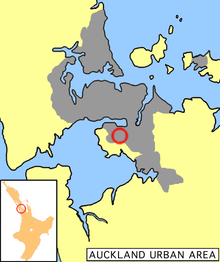Mangere
| Māngere | |
|---|---|

Māngere's location within the Auckland urban area
|
|
| Basic information | |
| Local authority | Auckland Council |
| Electoral ward | Manukau |
| Local board | Māngere-Ōtāhuhu |
| Population | 55,266 |
| Postcode(s) | 2022 |
| Facilities | |
| Railway station(s) | Middlemore Railway Station |
| Airport(s) | Auckland Airport |
| Surrounds | |
| North | Favona |
| East | Māngere East |
| Southeast | Wiri |
| Northwest | Māngere Bridge |
Māngere (frequently written Mangere; Māori pronunciation: [ˈmaːŋɛɾɛ], local /ˈmæŋəri/) is one of the largest suburbs in Auckland, in northern New Zealand. It is located on mainly flat land on the northeastern shore of the Manukau Harbour, to the northwest of Manukau City Centre and 15 kilometres south of the Auckland city centre. It is the location of Auckland Airport, which lies close to the harbour's edge to the south of the suburb.
Māngere has two major sub-areas: Māngere Bridge and Māngere East, with Favona in the east, sometimes counted as part of Māngere as well.
The suburb is named after Māngere Mountain, one of Auckland's largest volcanic cones. The title comes from the Māori words 'hau māngere' meaning lazy winds, after the shelter the mountain provides from the prevailing westerly wind.
Māngere is often described as a very multicultural area, with Europeans, Māori, Pacific Islanders and Asians living in the area, often with large families. Houses are a mixture of villas and bungalows, often located on former farms or market gardens developed by the state in the 1940s to 1960s.
Māngere's most famous son is David Lange, who was the Member of Parliament for Mangere from 1977 until 1996 and Prime Minister of New Zealand. Another local personality is former heavyweight boxing champion David Tua.
...
Wikipedia
